light CADILLAC STS V 2007 1.G Owners Manual
[x] Cancel search | Manufacturer: CADILLAC, Model Year: 2007, Model line: STS V, Model: CADILLAC STS V 2007 1.GPages: 560, PDF Size: 2.92 MB
Page 344 of 560
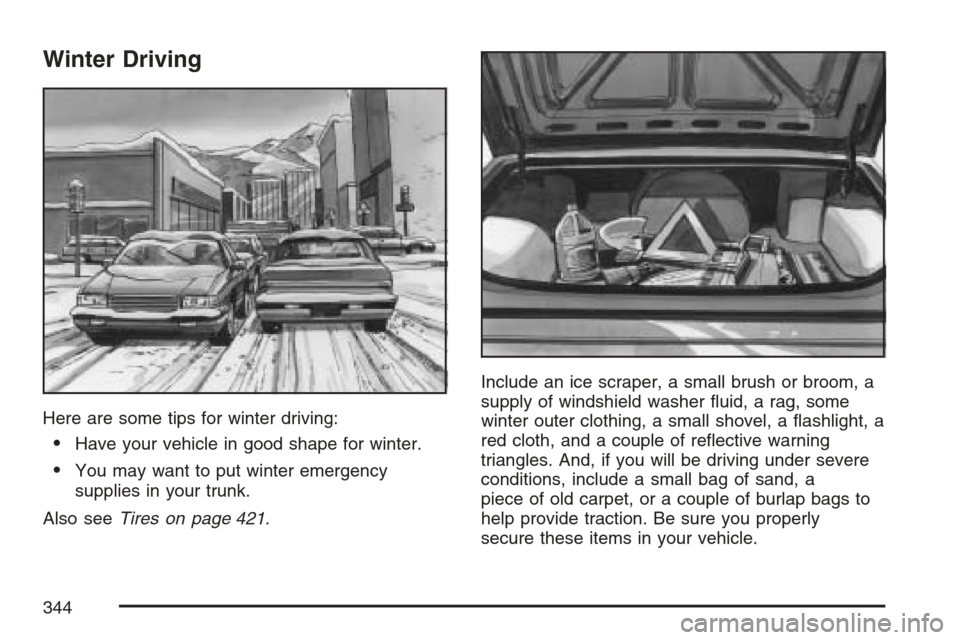
Winter Driving
Here are some tips for winter driving:
Have your vehicle in good shape for winter.
You may want to put winter emergency
supplies in your trunk.
Also seeTires on page 421.Include an ice scraper, a small brush or broom, a
supply of windshield washer �uid, a rag, some
winter outer clothing, a small shovel, a �ashlight, a
red cloth, and a couple of re�ective warning
triangles. And, if you will be driving under severe
conditions, include a small bag of sand, a
piece of old carpet, or a couple of burlap bags to
help provide traction. Be sure you properly
secure these items in your vehicle.
344
Page 347 of 560

You can run the engine to keep warm, but be
careful.
{CAUTION:
Snow can trap exhaust gases under your
vehicle. This can cause deadly CO
(carbon monoxide) gas to get inside. CO
could overcome you and kill you. You
cannot see it or smell it, so you might not
know it is in your vehicle. Clear away
snow from around the base of your
vehicle, especially any that is blocking the
exhaust pipe. And check around again
from time to time to be sure snow does
not collect there.
Open a window just a little on the side of
the vehicle that is away from the wind.
This will help keep CO out.
Run your engine only as long as you must. This
saves fuel. When you run the engine, make it go a
little faster than just idle. That is, push the
accelerator slightly. This uses less fuel for the
heat that you get and it keeps the battery charged.
347
Page 349 of 560
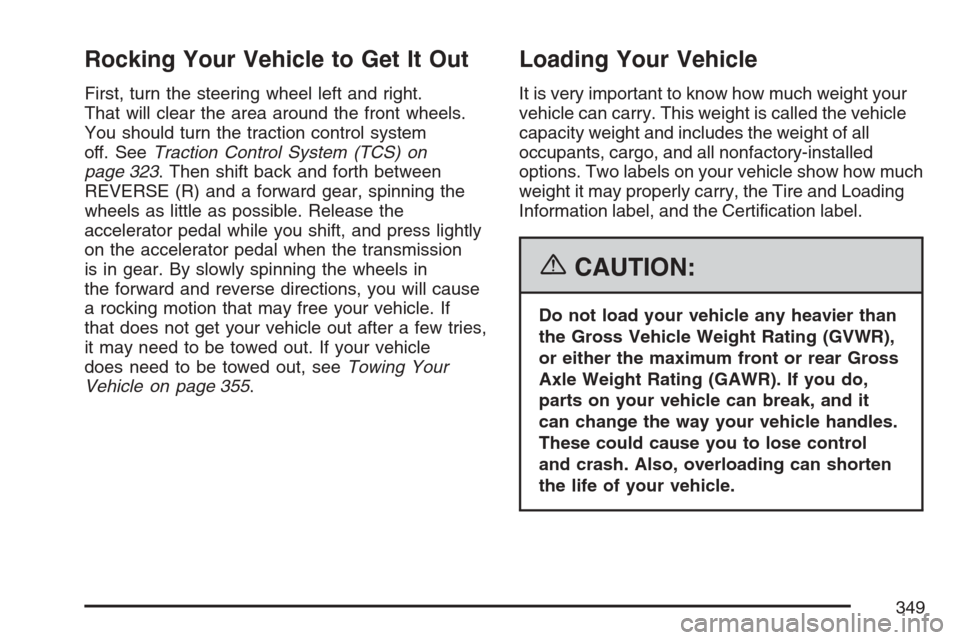
Rocking Your Vehicle to Get It Out
First, turn the steering wheel left and right.
That will clear the area around the front wheels.
You should turn the traction control system
off. SeeTraction Control System (TCS) on
page 323. Then shift back and forth between
REVERSE (R) and a forward gear, spinning the
wheels as little as possible. Release the
accelerator pedal while you shift, and press lightly
on the accelerator pedal when the transmission
is in gear. By slowly spinning the wheels in
the forward and reverse directions, you will cause
a rocking motion that may free your vehicle. If
that does not get your vehicle out after a few tries,
it may need to be towed out. If your vehicle
does need to be towed out, seeTowing Your
Vehicle on page 355.
Loading Your Vehicle
It is very important to know how much weight your
vehicle can carry. This weight is called the vehicle
capacity weight and includes the weight of all
occupants, cargo, and all nonfactory-installed
options. Two labels on your vehicle show how much
weight it may properly carry, the Tire and Loading
Information label, and the Certi�cation label.
{CAUTION:
Do not load your vehicle any heavier than
the Gross Vehicle Weight Rating (GVWR),
or either the maximum front or rear Gross
Axle Weight Rating (GAWR). If you do,
parts on your vehicle can break, and it
can change the way your vehicle handles.
These could cause you to lose control
and crash. Also, overloading can shorten
the life of your vehicle.
349
Page 359 of 560
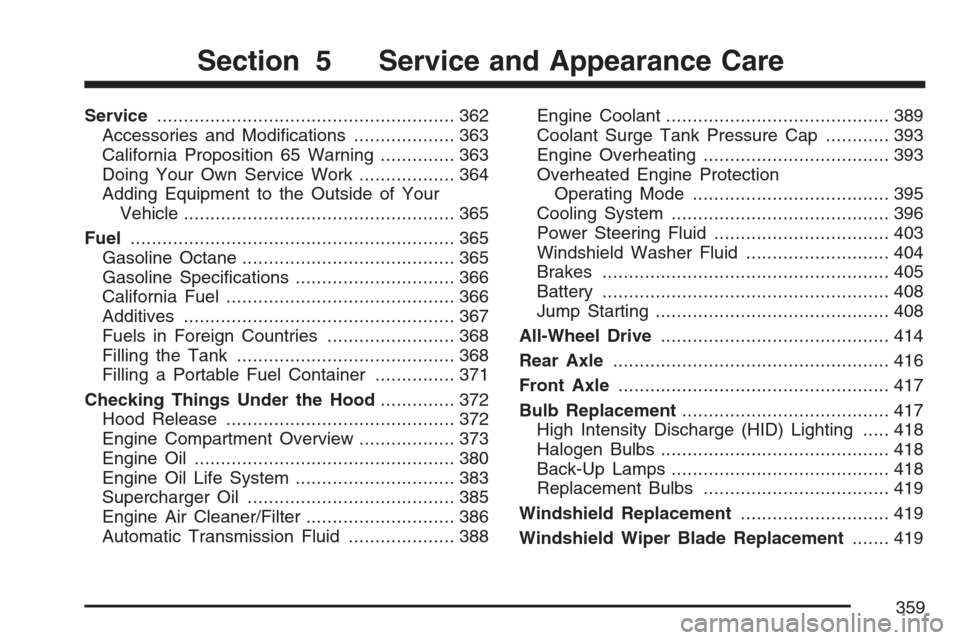
Service........................................................ 362
Accessories and Modi�cations................... 363
California Proposition 65 Warning.............. 363
Doing Your Own Service Work.................. 364
Adding Equipment to the Outside of Your
Vehicle................................................... 365
Fuel............................................................. 365
Gasoline Octane........................................ 365
Gasoline Speci�cations.............................. 366
California Fuel........................................... 366
Additives................................................... 367
Fuels in Foreign Countries........................ 368
Filling the Tank......................................... 368
Filling a Portable Fuel Container............... 371
Checking Things Under the Hood.............. 372
Hood Release........................................... 372
Engine Compartment Overview.................. 373
Engine Oil................................................. 380
Engine Oil Life System.............................. 383
Supercharger Oil....................................... 385
Engine Air Cleaner/Filter............................ 386
Automatic Transmission Fluid.................... 388Engine Coolant.......................................... 389
Coolant Surge Tank Pressure Cap............ 393
Engine Overheating................................... 393
Overheated Engine Protection
Operating Mode..................................... 395
Cooling System......................................... 396
Power Steering Fluid ................................. 403
Windshield Washer Fluid........................... 404
Brakes...................................................... 405
Battery...................................................... 408
Jump Starting............................................ 408
All-Wheel Drive........................................... 414
Rear Axle.................................................... 416
Front Axle................................................... 417
Bulb Replacement....................................... 417
High Intensity Discharge (HID) Lighting..... 418
Halogen Bulbs........................................... 418
Back-Up Lamps......................................... 418
Replacement Bulbs................................... 419
Windshield Replacement............................ 419
Windshield Wiper Blade Replacement....... 419
Section 5 Service and Appearance Care
359
Page 365 of 560

Adding Equipment to the Outside
of Your Vehicle
Things you might add to the outside of your
vehicle can affect the air�ow around it. This may
cause wind noise and affect windshield washer
performance. Check with your dealer before
adding equipment to the outside of your vehicle.
Fuel
Use of the recommended fuel is an important part
of the proper maintenance of your vehicle. To
help keep your engine clean and maintain optimum
vehicle performance, GM recommends the use
of gasoline advertised as TOP TIER Detergent
Gasoline.
The 8th digit of your Vehicle Identi�cation
Number (VIN) shows the code letter or number
that identi�es your engine. You will �nd the VIN at
the top left of the instrument panel. SeeVehicle
Identi�cation Number (VIN) on page 485.
Gasoline Octane
If your vehicle has the 3.6L V6 engine
(VIN Code 7), use regular unleaded gasoline with
a posted octane rating of 87 or higher. For
best performance or trailer towing, you may
choose to use middle grade 89 octane unleaded
gasoline. If the octane rating is less than 87,
you may notice an audible knocking noise when
you drive, commonly referred to as spark knock. If
this occurs, use a gasoline rated at 87 octane
or higher as soon as possible. If you are using
gasoline rated at 87 octane or higher and you hear
heavy knocking, your engine needs service.
If your vehicle has the 4.6L V8 engine
(VIN Code A), use premium unleaded gasoline with
a posted octane rating of 91 or higher. You may
also use regular unleaded gasoline rated at
87 octane or higher, but your vehicle’s acceleration
may be slightly reduced, and you may notice a
slight audible knocking noise, commonly referred to
as spark knock.
365
Page 370 of 560
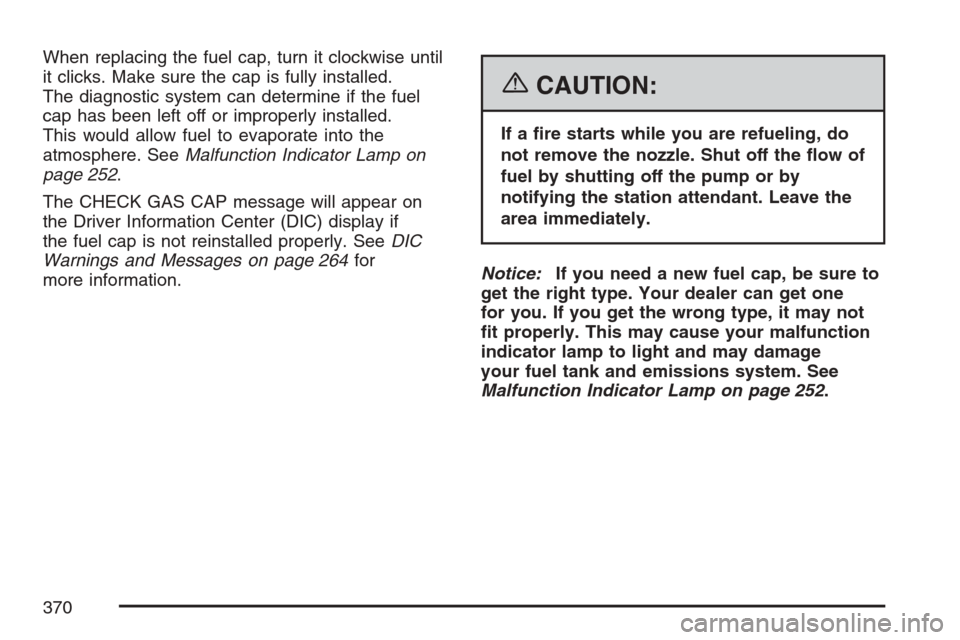
When replacing the fuel cap, turn it clockwise until
it clicks. Make sure the cap is fully installed.
The diagnostic system can determine if the fuel
cap has been left off or improperly installed.
This would allow fuel to evaporate into the
atmosphere. SeeMalfunction Indicator Lamp on
page 252.
The CHECK GAS CAP message will appear on
the Driver Information Center (DIC) display if
the fuel cap is not reinstalled properly. SeeDIC
Warnings and Messages on page 264for
more information.
{CAUTION:
If a �re starts while you are refueling, do
not remove the nozzle. Shut off the �ow of
fuel by shutting off the pump or by
notifying the station attendant. Leave the
area immediately.
Notice:If you need a new fuel cap, be sure to
get the right type. Your dealer can get one
for you. If you get the wrong type, it may not
�t properly. This may cause your malfunction
indicator lamp to light and may damage
your fuel tank and emissions system. See
Malfunction Indicator Lamp on page 252.
370
Page 384 of 560

When the system has calculated that oil life has
been diminished, it will indicate that an oil change is
necessary. A CHANGE ENGINE OIL SOON
message in the DIC will come on. SeeDIC
Warnings and Messages on page 264. Change
your oil as soon as possible within the next
600 miles (1 000 km). It is possible that, if you are
driving under the best conditions, the oil life system
may not indicate that an oil change is necessary for
over a year. However, your engine oil and �lter
must be changed at least once a year and at this
time the system must be reset. Your dealer has
GM-trained service people who will perform this
work using genuine GM parts and reset the system.
It is also important to check your oil regularly and
keep it at the proper level.
If the system is ever reset accidentally, you must
change your oil at 3,000 miles (5 000 km)
since your last oil change. Remember to reset the
oil life system whenever the oil is changed.How to Reset the Engine Oil Life
System
The Engine Oil Life System calculates when to
change your engine oil and �lter based on vehicle
use. Anytime your oil is changed, reset the
system so it can calculate when the next oil
change is required. If a situation occurs where you
change your oil prior to a CHANGE ENGINE
OIL SOON message in the DIC being turned on,
reset the system.
After the oil has been changed, the CHANGE
ENGINE OIL SOON message must be reset. To
reset the message use the following procedure:
1. Press the up or down arrow to scroll the DIC
to show OIL LIFE.
2. Once the XXX% ENGINE OIL LIFE menu item
is highlighted, press and hold the RESET
button until the percentage shows 100%.
If the percentage does not return to 100% or if
the CHANGE ENGINE OIL SOON message
comes back on when you start your
vehicle, the engine oil life system has not
reset. Repeat the procedure.
384
Page 386 of 560

Engine Air Cleaner/Filter
The engine air cleaner/�lter is in the engine
compartment on the driver’s side of the vehicle,
near the front. SeeEngine Compartment Overview
on page 373for more information on locating
the air cleaner/�lter.
When to Inspect the Engine Air
Cleaner/Filter
Inspect the air cleaner/�lter at the MaintenanceII
intervals and replace it at the �rst oil change
after each 50,000 mile (83 000 km) interval. See
Scheduled Maintenance on page 505for more
information. If you are driving in dusty/dirty
conditions, inspect the �lter at each engine
oil change.
How to Inspect the Engine Air
Cleaner/Filter
To inspect the air cleaner/�lter remove the �lter
from the vehicle and lightly shake the �lter to
release loose dust and dirt. If the �lter remains
caked with dirt, a new �lter is required.
To inspect or replace the �lter in the 3.6L V6 or
4.6L V8 engines, do the following:
1. Remove the two screws located on the top of
the cover.
2. Disconnect the coolant recovery hose so that
it is not going across the top of the engine air
cleaner/�lter.
4.6L V8 Engine shown, 3.6L V6 Engine similar
386
Page 389 of 560
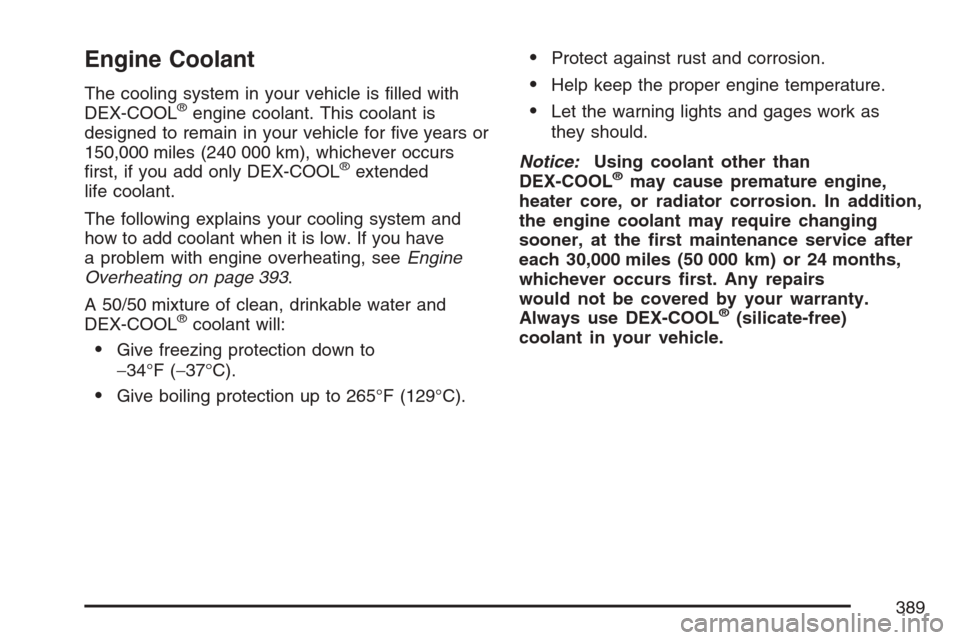
Engine Coolant
The cooling system in your vehicle is �lled with
DEX-COOL®engine coolant. This coolant is
designed to remain in your vehicle for �ve years or
150,000 miles (240 000 km), whichever occurs
�rst, if you add only DEX-COOL
®extended
life coolant.
The following explains your cooling system and
how to add coolant when it is low. If you have
a problem with engine overheating, seeEngine
Overheating on page 393.
A 50/50 mixture of clean, drinkable water and
DEX-COOL
®coolant will:
Give freezing protection down to
−34°F (−37°C).
Give boiling protection up to 265°F (129°C).
Protect against rust and corrosion.
Help keep the proper engine temperature.
Let the warning lights and gages work as
they should.
Notice:Using coolant other than
DEX-COOL
®may cause premature engine,
heater core, or radiator corrosion. In addition,
the engine coolant may require changing
sooner, at the �rst maintenance service after
each 30,000 miles (50 000 km) or 24 months,
whichever occurs �rst. Any repairs
would not be covered by your warranty.
Always use DEX-COOL
®(silicate-free)
coolant in your vehicle.
389
Page 393 of 560
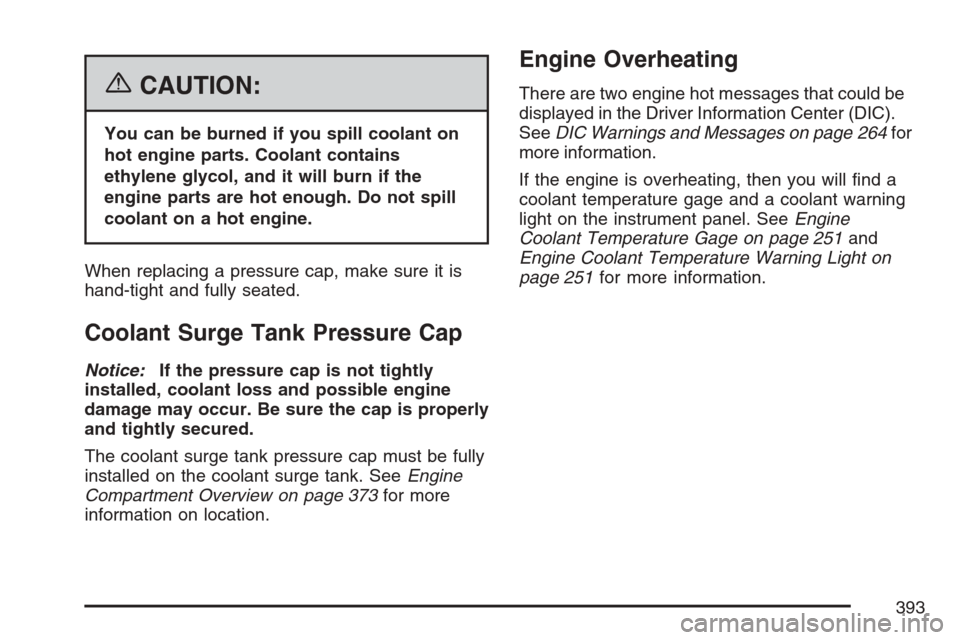
{CAUTION:
You can be burned if you spill coolant on
hot engine parts. Coolant contains
ethylene glycol, and it will burn if the
engine parts are hot enough. Do not spill
coolant on a hot engine.
When replacing a pressure cap, make sure it is
hand-tight and fully seated.
Coolant Surge Tank Pressure Cap
Notice:If the pressure cap is not tightly
installed, coolant loss and possible engine
damage may occur. Be sure the cap is properly
and tightly secured.
The coolant surge tank pressure cap must be fully
installed on the coolant surge tank. SeeEngine
Compartment Overview on page 373for more
information on location.
Engine Overheating
There are two engine hot messages that could be
displayed in the Driver Information Center (DIC).
SeeDIC Warnings and Messages on page 264for
more information.
If the engine is overheating, then you will �nd a
coolant temperature gage and a coolant warning
light on the instrument panel. SeeEngine
Coolant Temperature Gage on page 251and
Engine Coolant Temperature Warning Light on
page 251for more information.
393